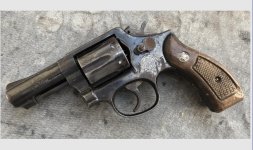... especially as applied to Smiths made within the past 20 years or so. I'm inclined not to list values for Poor and Fair condition for recently manufactured models. I don't think guns often get beat up that bad within their first two decades.
Has anyone actually bought or sold a recently made Poor or Fair condition Smith? How much?
Here are the definitions we use in the book (based on the NRA condition guidelines):
Has anyone actually bought or sold a recently made Poor or Fair condition Smith? How much?
Here are the definitions we use in the book (based on the NRA condition guidelines):
Fair: Modern guns must be in safe working condition, but can be well worn, showing visible repair or replacement parts, or needing adjustment or minor repair. May be pitted so long as pitting does not effect function or safety. Antique guns may have major parts replaced and minor parts missing, may be rusted, pitted, heavily buffed or refinished, may have rounded edges, illegible markings, cracked or broken grips, and should be working or easily repaired. For comparison, one version of NRA Modern definitions suggest “20-60% finish may or may not be original”.
Poor: Broken, poorly refinished, heavily rusted and pitted, or otherwise generally undesirable. Most often valued only as project guns for amateur gunsmiths, curiosities for display, or parts guns. Although rare models in “poor” condition may have some collector value, often the value of “poor” condition guns will be the value the gun would have if it were restored to shootable condition, less the cost of such repair, or the value of the salvageable parts remaining on the poor condition gun.
Poor: Broken, poorly refinished, heavily rusted and pitted, or otherwise generally undesirable. Most often valued only as project guns for amateur gunsmiths, curiosities for display, or parts guns. Although rare models in “poor” condition may have some collector value, often the value of “poor” condition guns will be the value the gun would have if it were restored to shootable condition, less the cost of such repair, or the value of the salvageable parts remaining on the poor condition gun.

